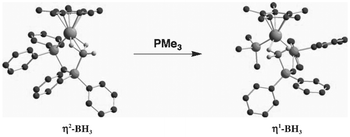44. Transition Metal Complexes of the Chelating Phosphine Borane Ligand Ph2PCH2Ph2P•BH3
Dalton Transactions 2004, 3883-3892

Merle, N.; Koicok-Kohn, G.; Mahon, M. F.; Frost, C. G.; Ruggerio, G. D.; Weller, A. S.; Willis, M. C.

Chromium and ruthenium complexes of the chelating phosphine borane H3B. dppm are reported. Addition of H3B. dppm to [Cr(CO)4(nbd)] (nbd = norbornadiene) affords [Cr(CO)4(eta(1)- H3B. dppm)] in which the borane is linked to the metal through a single B - H - Cr interaction. Addition of H3B. dppm to [CpRu(PR3)(NCMe)2]+ (Cp = eta(5)-C5H5) results in [CpRu(PR3)(eta(1)- H3B. dppm)][PF6] (R= Me, OMe) which also show a single B - H - Ru interaction. Reaction with [CpRu(NCMe)3]+ only resulted in a mixture of products. In contrast, with [Cp* Ru(NCMe)3]+ (Cp* = eta(5)-C5Me5) a single product is isolated in high yield: [Cp* Ru(eta(2)-H3B. dppm)][PF6]. This complex shows two B - H - Ru interactions. Reaction with L = PMe3 or CO breaks one of these and the complexes [Cp* Ru(L)(eta(1)- H3B. dppm)][PF6] are formed in good yield. With L = MeCN an equilibrium is established between [Cp* Ru(eta(2)-H3B. dppm)][PF6] and the acetonitrile adduct. [Cp* Ru(eta(2)-H3B. dppm)][PF6] can be considered as being "operationally unsaturated", effectively acting as a source of 16-electron [Cp* Ru(eta(1)- H3B. dppm)][PF6]. All the new compounds (apart from the CO and MeCN adducts) have been characterised by X-ray crystallography. The solid-state structure of H3B. dppm is also reported.

